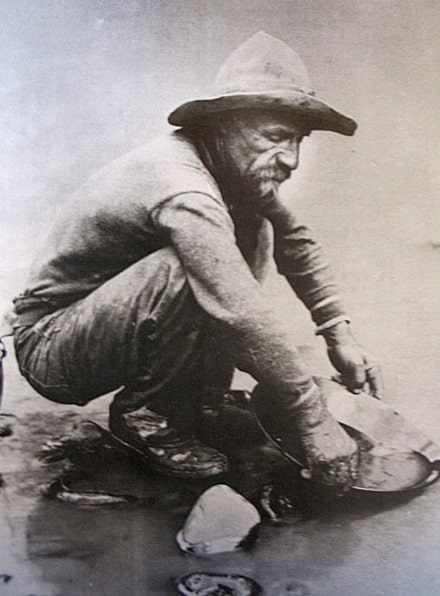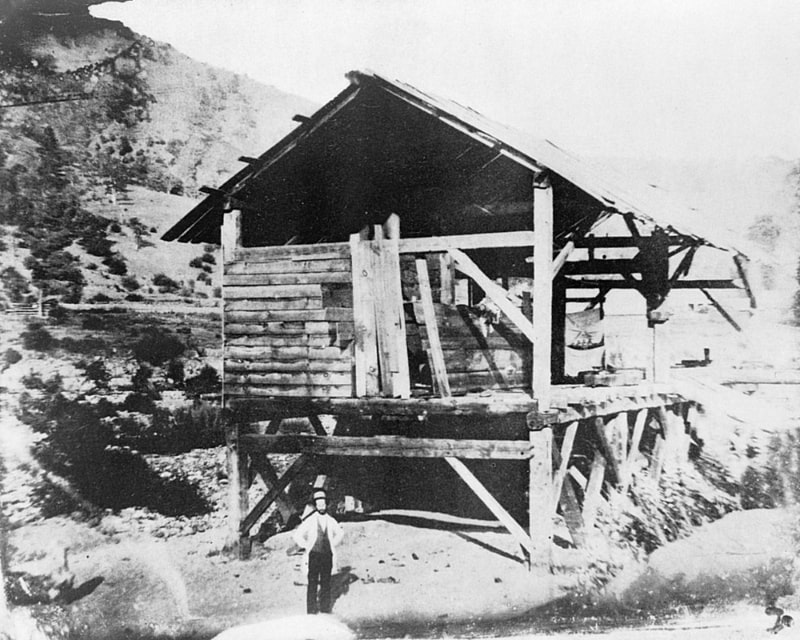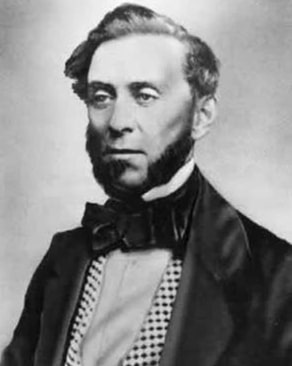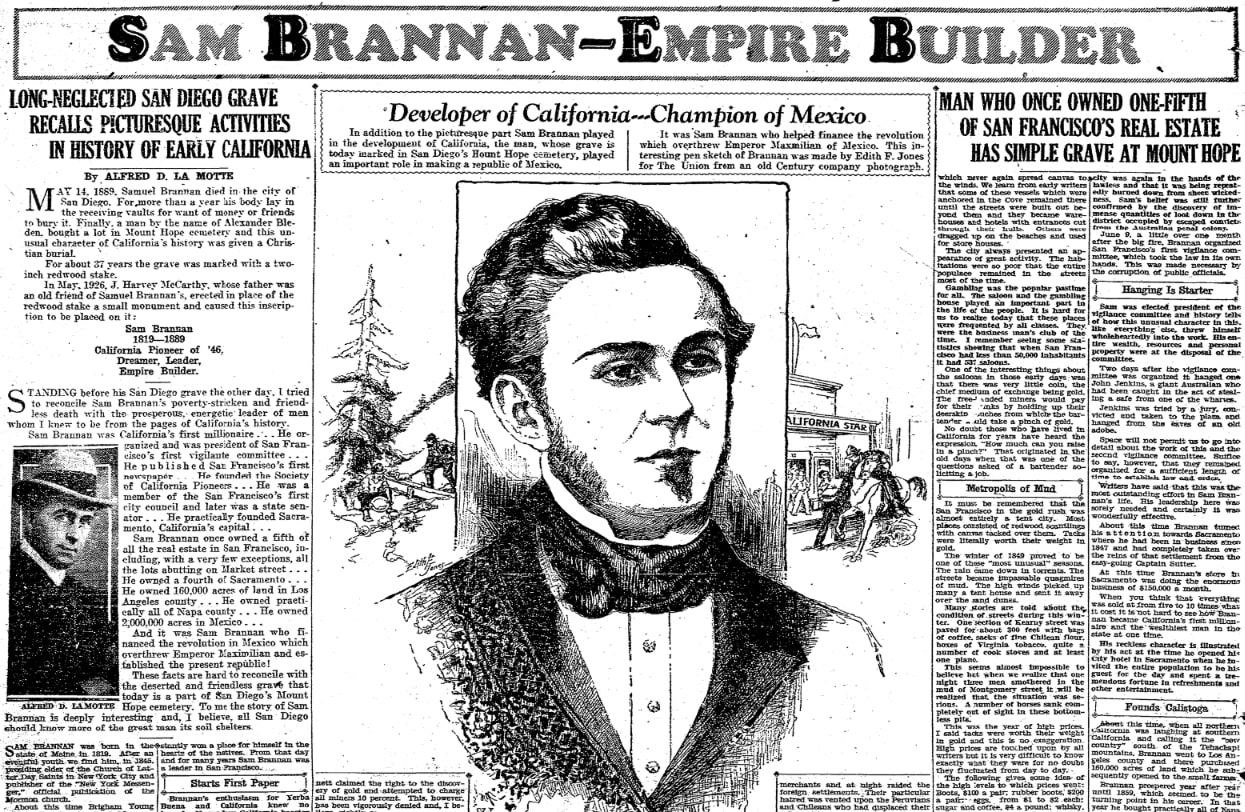Introduction: In this article, Melissa Davenport Berry writes about the California Gold Rush and one man in particular: Sam Brannan. Melissa is a genealogist who has a blog, AnceStory Archives, and a Facebook group, New England Family Genealogy and History.
Was your ancestor a gold digger? Find out by searching GenealogyBank’s Historical Newspaper Archives. Just type in “California Gold” on the search page, and thousands of results from almost every state come up listing names and events connected to the California Gold Rush (1848-1855).
GenealogyBank has a gold mine of information on this period in history, during which over 300,00 persons (known as the “49ers” because 1849 was the peak year for arrivals) made the journey to California to seek their fortune in gold.

I was inspired to find out more about this event in history when a reader shared her great grandfather’s story of the Gold Rush. Stay tuned for this story and many others about people who made the dash to search for gold in California’s streams and riverbeds.
The mania for California gold came about when a carpenter, James Wilson Marshall, discovered shiny nuggets of gold on 24 January 1848 in the South Fork of the American River, in the foothills of the Sierra Nevada Mountains.

Marshall was erecting a lumber mill for Captain John Sutter, known as Sutter’s Mill, located in Coloma. Sutter wanted to keep this lucrative discovery quiet but word got out, and then the press leaked it – and the rush was on.

I found a very interesting article written by Alfred D. La Motte in the San Diego Union that detailed the events and the man, Samuel Brannan, who was mainly responsible for publicizing the gold discovery.

Sam Brannan was born in 1819 in Saco, Maine, to Thomas Brannan and Sarah Anne Knox Emery, and died on 14 May 1889 in San Diego. He founded the first newspaper in San Francisco, the California Star, and made a fortune selling equipment and supplies to the gold prospectors.
However, as this article explained, Sam Brannan later had personal and financial difficulties, and died penniless and friendless. As La Motte wrote:
For more than a year his [Brannan’s] body lay in the receiving vaults for want of money or friends to bury it. Finally, a man by the name of Alexander Bleden bought a lot in Mount Hope Cemetery and this unusual character of California’s history was given a Christian burial. For about 37 years the grave was marked with a two-inch redwood stake.
Finally, the son of one of Brannan’s friends, J. Harvey McCarthy, replaced the redwood stake with a memorial stone with the inscription:
Sam Brannan
1819-1889
California Pioneer of ’46,
Dreamer, Leader,
Empire Builder.
La Motte was curious why Brannan left this earth poor and lonely. After all, he was the first millionaire in California, founded the Society of California Pioneers, organized and served as president of the first vigilante committee, was one of the first members of the San Francisco city council, and later became a state senator. He owned a great deal of real estate in the area, including most of Napa Valley. He financed the revolution which overthrew Emperor Maximilian and established the Mexican Republic.
Here is a summary of what La Motte shared on Brannan and his connection to the gold rush:
In 1845 Brannan was a presiding elder of the Church of Latter-day Saints in New York and publisher of the “New York Messenger,” the official publication of the Mormon Church.
Brigham Young was leading his band of Mormons westward from Nauvoo, Illinois, to search for “the promised land,” while Brannan was instructed by the Church to charter the ship Brooklyn and carry 236 Mormons to do the same.

The Brooklyn made a stop in the Hawaiian Islands and Brannan, along with the help of Commodore Robert Field Stockton of the U.S.S. Congress, drilled his fellow Mormons into a battalion of soldiers to prep them against any attacks when they arrived in their new land. It was foreseen that a war between Mexico and the Unites States was on the horizon.
On 31 July 1846 the Brooklyn sailed through the Golden Gate and set up to nest in Yerba Buena (San Francisco). The small town’s population at that time was about 60 people, and the new arrivals were welcomed as only two of its residents were women.
La Motte noted that Brannan’s presence and personality was attractive and charismatic, calling him “a natural born leader of men” and “a master of mob psychology.”
One of the first things Brannan did was to establish his newspaper, the California Star. He sent out a few thousand copies via Pony Express to the residents along the Mississippi River, hoping to recruit them to San Francisco.
He furthered his campaign to populate the town by making a trip over the Sierras to find Brigham Young, hoping to bring him and his band back to California, but those plans did not pan out.
When Young saw Salt Lake Valley he raised his hands toward the heavens and said, “This is the place!” Disappointed that he could not persuade Young to leave, Brannan made the journey back to California alone.
Brannan’s luck would soon turn. On his way back he stopped at Fort Sutter (now Sacramento) and decided to set up a general mercantile store. He started his new enterprise in the autumn of 1847.
Then in January of the following year Marshall found the gold. The rival San Francisco newspaper to Brannan’s California Star beat his paper to the punch, when the Californian published the news of the gold discovery on 15 March 1848.

Now here is the skinny on Sam Brannan’s play in the drama, as reported in La Motte’s own words from the above San Diego Union article:
It seems there were a number of Mormons from Sam’s old battalion working on the mill, and as soon as the gold discovery was made they started down the river prospecting for themselves, and made a rich strike at a place that is known today as Mormons’ Island. About this time Colonel [Richard Barnes] Mason, then military governor of the district, together with Lt. William Tecumseh Sherman, his aide, made a trip up the river to verify the gold discovery. Sherman, in his memoirs, tells of meeting Sam Brannan at Mormons’ Island and finding him there busily collecting the Lord’s tithe.
One of the men asked Colonel Mason if Brannan, as their high priest, had a legal right to take the Lord’s money from them. Mason is said to have replied that he most certainly did have that authority as long as they were fools enough to pay.
Brannan stocked his store to furnish all the tools, supplies, and staples the gold prospectors needed.
Stay tuned…
Explore over 330 years of newspapers and historical records in GenealogyBank. Discover your family story! Start a 7-Day Free Trial
Note on the header image: prospectors working gold placer deposits on 9 July 1850 during the California Gold Rush. Credit: Wikimedia Commons.

Wow Melissa, it’s so fascinating to discover what brought our ancestors here to the West Coast. One census they were back East. The next census they are in Northern California. I’m sure the newspapers in GenealogyBank have so much information about this. Incredibly interesting to read about the Oregon Trail, and steamer ships to San Francisco. I’m looking forward to reading your upcoming series and get tips on searches through GenealogyBank!
Thank you, Denise! And thanks for sending the letters on your 49er ancestor; looking forward to sharing his story! Stay tuned!